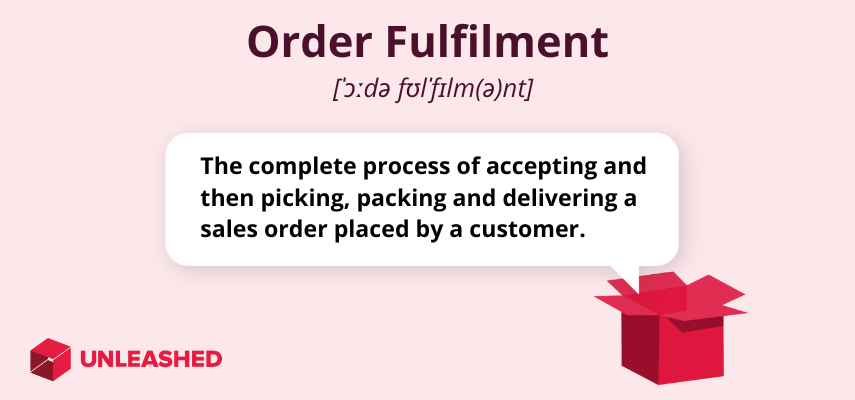
The order fulfilment process can be tricky to get right. There are many steps to follow, and different tactics available for every business model. But by following the best practices mentioned in this guide and optimising your fulfilment approach, you can efficiently fulfil every future customer order with confidence.
What is order fulfilment?
Order fulfilment is how an order is received, processed, and delivered to a customer. The order fulfilment process covers every step required to get goods to the people who purchase them, from the moment a customer places an order to when they receive their purchase.

Some of the main steps involved in the order fulfilment process include:
- Inventory management
- Picking and packing
- Tracking and communication
- Shipping and delivery
- Customer service
- Returns management
Fulfilment costs can represent up to 30% of an eCommerce company’s total operating expenses. But cost-saving isn’t the only benefit of an optimised fulfilment process.
Efficient order fulfilment is also crucial for customer satisfaction and retention.
It involves coordinating various departments within a business – such as sales, inventory management, and shipping – to ensure that orders are processed accurately and delivered promptly.
When these processes are aligned, customer satisfaction improves. When they’re deoptimized, you can wave goodbye to customer loyalty.
The function of order fulfilment in supply chain management
In supply chain management, order fulfilment acts as the bridge between customer demand and product delivery. Its role is to ensure that customers receive their ordered products accurately and on time.
Some key functions of order fulfilment in the supply chain include:
- Ordering processing: Receiving and confirming a customer order and passing the details on to the appropriate team or employee for fulfilment. This step also involves reviewing the customer’s order to check its accuracy and the availability of products.
- Picking and packing: Getting the products ready for a customer after an order has been placed. When an order is confirmed, the items need to be collected from inventory and packaged for shipment.
- Shipping and logistics: Selecting the appropriate shipping method, arranging transport, and coordinating with couriers for delivery. This can include freight forwarding and documentation management.
- Communication and tracking: Once an order is fulfilled, delivery and customer satisfaction should be tracked. Providing customers with updates, including tracking information, allows them to access real-time progress of their orders.
- Data collection and analysis: Gathering data throughout the fulfilment process provides valuable insights to identify areas for improvement, streamline operations, and make informed decisions.
- Cost efficiency and optimisation: Effective order fulfilment helps to minimise costs associated with processes like inventory holding, shipping, and returns processing. It also ensures that resources are used efficiently.
- Compliance and documentation: Ensuring that all legal and regulatory requirements are met. This is particularly crucial in international shipping, where customs documentation and compliance with import and export regulations are essential.
- Integration with other supply chain functions: Order fulfilment connects with other aspects of the supply chain – such as procurement, production planning, and demand forecasting – to ensure alignment and smooth operations.
Order fulfilment is just one part of the supply chain. But as the process responsible for delivering ordered products to customers, it’s one of the most important elements to get right.
Order fulfilment vs. shipping: What’s the difference?
Order fulfilment and shipping are related processes in the journey of getting products to customers. However, they represent distinct stages.
Here’s the difference:
- Order fulfilment encompasses the entire process, from order processing to picking, shipping, tracking, delivery and returns, it’s end-to-end.
- Shipping specifically refers to the transportation of goods from one location to another – typically from the seller’s distribution centre or warehouse to the buyer's address.
In short, shipping is a necessary component of order fulfilment but functions as only one part of the broader process.
Why is order fulfilment important to get right?
Order fulfilment is ultimately responsible for order accuracy and speed. 24% of online shoppers abandon their carts at checkout because shipping times are slower than desired. If orders are not fulfilled correctly – or fast enough – it can negatively affect the customer experience.
9 reasons it’s important to get order fulfilment right:
- Customer satisfaction: Order fulfilment directly impacts the customer's experience. When orders are processed accurately and delivered on time, it builds trust. This leads to customer loyalty and positive word-of-mouth, which are invaluable for a business.
- Reputation and brand Image: Efficient order fulfilment also reflects positively on a company's reputation. Consistently getting orders right demonstrates reliability and professionalism, enhancing the brand's image in the market.
- Competitive advantage: When it comes to making a purchase, customers usually have several options to choose from. Businesses that excel in order fulfilment have an opportunity to stand out.
- Reduced operating costs: Effective order fulfilment can minimise costs associated with processes like inventory management, packing, and shipping. This helps in maintaining healthy profit margins and staying competitive in pricing.
- Optimised inventory levels: By managing inventory efficiently, businesses can strike the right balance between overstocking (which ties up capital) and stockouts (which lead to lost sales and frustrated customers).
- Minimise returns and exchanges: A refined order fulfilment process helps to reduce the number of returns and exchanges, saving time, resources, and costs associated with handling and processing returns.
- Decision making: Order fulfilment done right can provide valuable data on customer preferences, demand patterns, and operational efficiencies. This data can be analysed to make well-informed decisions regarding inventory management, supplier relationships, and process improvements.
- Efficient use of resources: Properly executed order fulfilment maximises the use of resources, including labour, warehouse space, and transportation. This leads to cost savings and improves overall operational efficiency.
- Adaptability to market changes: An agile order fulfilment process allows businesses to respond quickly to changing market demands. This is crucial in dynamic industries where rapid shifts in consumer preferences or market conditions occur.
Now the importance of nailing getting order fulfilment right is clear, let’s look at the optimal process for doing just that.

Order fulfilment process
Depending on your business and the products you sell, the order fulfilment process may be short and sweet, or long and complex. According to one report, small online retailers experience an average order fulfilment speed of 16 hours.
However, averages mean very little without context. More important than the number of hours it takes to fulfil an order is whether you’re doing it correctly.
Let’s look at the seven main steps in the order fulfilment process.
1. Inventory management
Inventory management involves overseeing the quantity, location, and status of products within a business’s stock. Effective inventory management ensures that products are available when customers place orders and require careful monitoring of demand patterns, sales trends, and supplier lead times to strike the right balance.
2. Sales order processing
Sales order processing is where a customer order is checked for availability before sending through the picking request. Precise sales order processing is important so that customers receive what they've ordered within the expected timeframe.
3. Order picking and packing
Order picking involves retrieving the specific items from the inventory shelves to fulfil a customer's order. It requires an accurate approach so that the correct products are selected in the right quantities.
Packing in the order fulfilment process is where the selected items are carefully and securely prepared for shipment to the customer. It will also include labelling with shipping information, tracking numbers, and any necessary documentation for international shipments.
4. Shipping and delivery
Shipping and delivery in the order fulfilment process is the final stage where the packed items are handed over to the chosen carrier for transportation to the customer's specified destination.
It involves coordinating with shipping partners, selecting the appropriate shipping method based on factors like speed and cost, and ensuring compliance with any relevant regulations or requirements. It may also include providing the customer with tracking information, allowing them to monitor the progress of their order.
5. Backorder management
Backorder management addresses situations where a product is temporarily out of stock but still ordered by a customer. It involves a strategic approach and may include providing estimated restock dates or offering alternative products if available.

Order fulfilment challenges
No matter the size of a business’s operations, problems can arise in the order fulfilment process.
These are the order fulfilment challenges you’re most likely to encounter:
- Inventory control: Maintaining precise and up-to-date inventory records is a constant challenge. Inaccurate counts can lead to stockouts or overstocking, both of which have significant cost implications.
- Order accuracy: Achieving both accuracy and speed in the picking and packing process is a balancing act. Inaccurate orders lead to more returns and unhappy customers. Poorly packed items can lead to damage during transit. Slow packing can delay order processing.
- Multichannel order management: For businesses selling through various sales channels or from different warehouses, it can be more difficult (and costly) to keep track of stock locations and inventory levels.
- Technology integration: Ensuring that different software systems – such as inventory management, order processing, and shipping software – work seamlessly together is crucial for a smooth order fulfilment process.
- Supplier management: Managing suppliers requires consistent and clear communication from both sides. Delays or disruptions in the supply chain can have a effect on order fulfilment.
- Capacity constraints: Warehousing and fulfilment centres may face limitations in terms of space and labour, particularly during periods of high demand. Balancing growth with capacity is never an easy task.
Addressing these challenges requires a holistic approach that combines effective technology, streamlined processes, and skilled personnel to establish and maintain a streamlined order fulfilment process.
Types of order fulfilment
Order fulfilment can largely be divided into three main types:
- Ecommerce fulfilment
- B2B fulfilment
- Third-party logistics
Let’s quickly break these down.
1. Ecommerce order fulfilment
Ecommerce order fulfilment is the process specific to online retail, where customer orders are received, processed, and shipped out from an online store's inventory.
Given the nature of online shopping, speed and accuracy are paramount in ecommerce order fulfilment, as is communication with customers regarding order status and tracking information.
Ecommerce businesses often face unique challenges like managing high order volumes, coordinating with multiple shipping carriers, and ensuring seamless integration between their online platform and fulfilment systems.
2. B2B order fulfilment
B2B (business-to-business) order fulfilment is the process of handling and completing orders between businesses, rather than individual consumers.
Accuracy and reliability are essential in B2B order fulfilment, as businesses often rely on timely deliveries to maintain their own operations. Additionally, B2B transactions may involve bulk orders or recurring contracts, necessitating efficient inventory management and clear communication channels between trading partners.
A customisable B2B ecommerce portal with the option to set individual pricing for each customer can be highly useful for fulfilling B2B orders.
Unlike B2C (business-to-consumer) transactions, B2B order fulfilment often requires specialised services, such as customised packaging or specific delivery schedules.
3. 3PL order fulfilment
Third-party logistics (3PL) order fulfilment is a service provided by external companies specialised in managing various aspects of the supply chain process on behalf of businesses.
In 3PL order fulfilment, a third-party logistics provider takes on responsibilities such as warehousing, inventory management, picking and packing of products, and shipping. This arrangement allows businesses to focus on their core operations while entrusting the complexities of logistics to experts.
Order fulfilment strategies
There are several order fulfilment strategies that you can implement in your business. Consider your size, needs, location, suppliers, and the products being sold when deciding which strategies are right for you.
Common order fulfilment strategies include:
- Direct to consumer (DTC): This strategy involves selling products directly to consumers through an online platform or a physical store. It allows businesses to have full control over the customer experience, from order placement to delivery.
- Dropshipping: In this model, businesses partner with suppliers who handle the storage, packing, and shipping of products directly to the customer. This eliminates the need for the business to hold inventory.
- In-house fulfilment: This approach involves managing all aspects of order fulfilment internally, from warehousing to packing and shipping. It provides maximum control over the process but requires significant infrastructure and resources.
- Outsourced fulfilment (3PL): Utilising a third-party logistics provider (3PL) involves contracting an external company to handle various aspects of the order fulfilment process. This can include warehousing, picking and packing, and shipping.
- Cross-docking: This strategy involves receiving goods from suppliers and immediately transferring them to outbound carriers with minimal storage time. It's particularly useful for high-volume, time-sensitive products.
- Multi-warehouse fulfilment: Businesses maintain multiple warehouses in strategic locations to reduce shipping distances and times. This helps in meeting customer demands quickly and cost-effectively.
- Just-in-time (JIT) fulfilment: This lean inventory management approach involves receiving goods only as they are needed in the production process or for order fulfilment. It minimises holding costs but requires precise planning.
- Bulk shipment and break-pack fulfilment: This strategy involves receiving goods in bulk and repackaging them into individual units for order fulfilment. It's common in industries like retail.
- Batch and wave picking: Batch picking involves picking multiple orders simultaneously, while wave picking groups similar orders together for efficient processing. These strategies optimise order-picking efficiency.
- Dynamic slotting: This involves continuously reorganising the placement of products in the warehouse based on demand patterns, to optimise picking and packing operations.
Often, a combination of these strategies can be employed to create a customised fulfilment approach that best suits the specific needs of your business.

How to improve order fulfilment: 5 actionable tips
If you’re looking to improve your order fulfilment processes, get started with these five actionable tips.
1. Optimise inventory management
Implement robust inventory tracking systems to ensure accurate stock levels and conduct regular audits and cycle counts to catch discrepancies early.
53% of companies say automation reduces their fulfilment costs. Utilise demand forecasting tools to anticipate product needs and prevent overstocking or stockouts, and use warehouse management systems (WMS) and order management systems (OMS) to streamline operations and improve visibility.
2. Streamline order processing
Leverage automation and technology, such as omnichannel fulfilment software, for order processing to reduce manual errors. Implement efficient order routing and prioritisation based on factors like shipping speed or customer urgency. Develop contingency plans for handling spikes in demand during busy periods and coordinate closely with suppliers, carriers, and staff to ensure seamless operations.
3. Enhance order picking, packing and labelling efficiency
Organise the warehouse logically to minimise travel time for pickers. Utilise batch-picking or zone-picking strategies to maximise productivity.
Accuracy is also important. Standardise packing procedures to ensure consistency and accuracy. Use clear, easy-to-read labels on packages for accurate sorting and delivery. Where possible, you should also integrate with shipping carriers and use barcode scanning for greater accuracy.
4. Invest in employee training
Provide comprehensive training to staff on order fulfilment procedures and technology usage, and regularly update training to incorporate new tools and best practices.
You should encourage a culture of continuous improvement within the fulfilment team. Solicit feedback from employees (and customers) to identify areas for enhancement.
5. Implement quality control checks and monitor KPIs
Conduct regular inspections of packed orders to catch any errors or damaged items before shipping and have a standardised process for handling returns and exchanges.
Regularly track and analyse order fulfilment KPIs to identify areas for improvement. Choose couriers/shipping providers based on factors like transit times, reliability, and cost-effectiveness. Use data to make informed decisions and implement process enhancements.
Order fulfilment software features
Order fulfilment software enables you to automate and streamline the fulfilment process for improved accuracy, speed, and traceability. If you’re investing in order fulfilment software for your business, there are a few features you should be on the lookout for.
A non-negotiable is real-time visibility into your inventory levels, so you can track stock availability, monitor restocking needs, and prevent overstocking or stockouts. It should also automate order processing tasks – from order receipt to picking and packing – to reduce manual errors and ensure orders are fulfilled accurately.
In today’s selling environment, multichannel integration is highly important.
You want the software to seamlessly integrate with your various sales channels, including ecommerce platforms, marketplaces and physical stores. This will centralise your order management.
Other key order fulfilment software functions include:
- Returns management
- Shipping management
- Reporting and analytics
- Barcode scanning
- Customisation and scalability
- Seamless integrations
- User-friendly interface
- Security and data protection
By incorporating these features, order fulfilment software can streamline processes, improve accuracy, and elevate the overall order fulfilment process.
- Related: See how order management systems compare with ERP software for order fulfilment in this guide.

How to source and compare order fulfilment services
Sourcing and comparing various order fulfilment systems or services requires a clear and strategic evaluation process.
First, identify your specific fulfilment needs and objectives.
Once you know what functionalities or services your business requires, conduct thorough market research to identify potential vendors or providers. This may involve seeking recommendations from industry peers, consulting online reviews, and attending trade shows or conferences.
Make sure you request proposals or demos from selected providers to get a hands-on understanding of their capabilities. Additionally, consider factors like scalability, customisation options, integration capabilities, and pricing models.
Assess each system against the criteria you defined at the start of the process, and prioritise each provider based on how well they align with your business goals and budget constraints.
